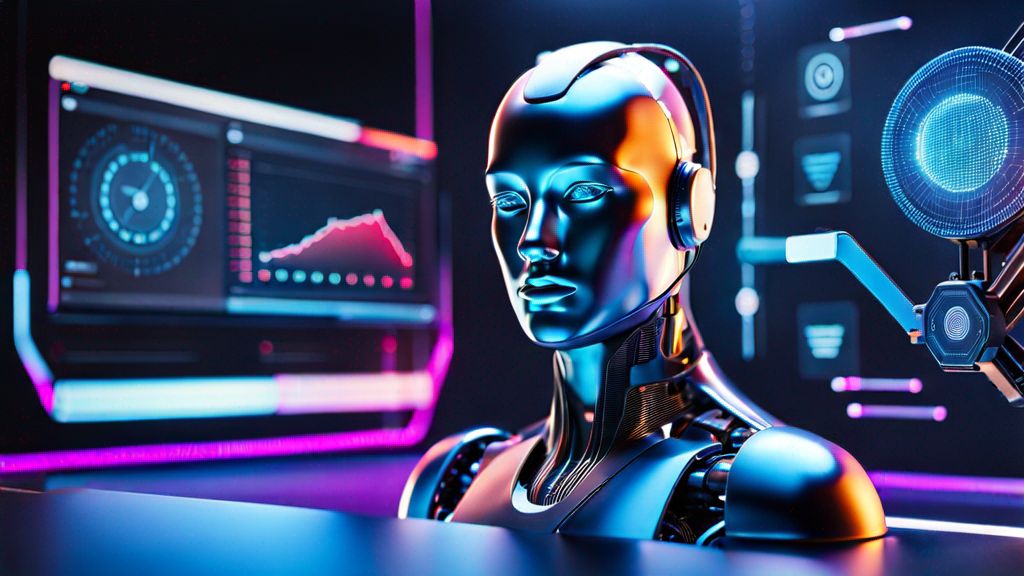🎧 Listen (19 minutes)
In an era where efficiency and productivity are paramount, businesses are constantly looking for innovative ways to streamline operations. One of the most effective strategies that is rapidly gaining traction is the integration of Artificial Intelligence (AI) into the company workflow. This not only improves efficiency but it also significantly impacts bottom-line growth.
In this in-depth article, we will be discussing the concept of AI, how it relates to workflow efficiencies, and how businesses can leverage AI Automation to optimize their operations.
Understanding the Concept of AI and AI Automation
Simply put, artificial intelligence (AI) refers to programmed systems or machines that can carry out tasks requiring human intelligence. These tasks range from interpreting complex data and recognizing patterns to decision-making and speech recognition. AI encompasses multiple technologies including machine learning, neural networks, and natural language processing which help in simulating human intelligence in machines.
AI automation speaks to the aspects of AI that can perform repetitive tasks without human intervention. It’s about leveraging AI technologies to automate routine tasks, thus freeing up human time for complex and creative problem-solving activities. From managing and tracking inventory, handling customer inquiries, to analyzing consumer behavior, AI automation can bring a transformational change in the way businesses operate.
The Intersection of AI and Workflow Efficiencies
Workflow efficiency is about how well business process flows from one operation to another— how quickly and how less resource-intensive these processes are. It relates to everything from completing customer orders to launching new products and handling finance. Perfecting this process is crucial for any business hoping to keep pace with the modern marketplace.
This is the juncture where the versatility of AI meets the necessity of workflow efficiencies. The ability of AI to process large volumes of data in real time, create detailed reports, forecast trends, and make reasoned business decisions helps to streamline processes, reduce errors, and save time— vital parameters to influence workflow efficiencies.
Orientating Towards AI Automation
Moving towards AI automation is not necessarily about replacing humans but enhancing their capabilities. AI can shoulder repetitive tasks, reducing the risk of human errors and allowing employees to focus on strategic and creative aspects that require a human touch. AI automation helps businesses to achieve several objectives at the same time – improving employee productivity and satisfaction, providing a better customer experience, and optimising business operations.
The Potential of AI in Different Business Areas
AI’s potential extends beyond just simple task automation. It has influencing power in various functional areas of a business. For instance, AI in human resources entails automating repetitive jobs like screening resumes and scheduling interviews, therefore reducing the time recruiters spend on these tasks. In sales and marketing, AI can analyze data to predict consumer behavior, personalize customer experience, and optimize sales processes. In customer service, AI can assist in responding to customer queries more accurately and quickly by suggesting answers to service representatives or directly engaging with customers via AI chatbots.
Tips to Leverage AI Automation for Optimizing Workflow
Lastly, we delve into practical steps businesses could take to leverage AI automation to optimize their workflow, from identifying automation opportunities, selecting suitable AI tools, to employee training, and continuous performance evaluation.
This article aims to highlight the transformative power of AI automation and how businesses can utilize it to optimize their workflow efficiencies. Read on to gain insightful knowledge and practical advice that will help not just understand the influence of AI on workflow efficiencies, but to also harness its potential for your business success.
Recommended Reading
To further your understanding and application of AI to enhance business workflow, we have curated a list of three insightful books. These books equip you with more practical tips and strategies to leverage AI technology for your business operations.
1. “Predictive Analytics: The Power to Predict Who Will Click, Buy, Lie, or Die” by Eric Siegel
This book demystifies the concept of predictive analytics and AI, and their ability to revolutionize business operations. Siegel breaks down complex AI jargon into layman’s terms and engaging anecdotes, making the book an accessible read for all levels. It centers around AI’s power in predicting consumer behavior, allowing businesses to make data-driven decisions and optimize their workflow.
2. “The Fourth Age: Smart Robots, Conscious Computers, and the Future of Humanity” by Byron Reese
Reese examines the impact of AI on the future of humanity and businesses. He explores how AI and automation can help organizations reduce repetitive tasks, eliminate errors, and boost productivity. The book provides a thoughtful perspective on AI’s role within workflow efficiencies, influencing employee productivity and business operations as a whole.
3. “Automate This: How Algorithms Came to Rule Our World” by Christopher Steiner
This book is about the significant achievements of AI and automation. Steiner provides a range of real-world examples spanning from the Wall Street to the medical sector, offering insights into the transformative power of AI and automation. The book encourages businesses to embrace AI technology to harness its potential and optimize their workflow.
By gaining a deeper perspective from these books, you can make more informed decisions and apply smarter strategies to integrate AI automation into your workflow. Arm yourself with these resources to successfully navigate the dawn of AI in business.
Identifying Automation Opportunities
The first step in leveraging AI for maximizing workflow efficiency is identifying areas ripe for automation. Potential opportunities range from manual, repetitive tasks hindrance to productivity, to complex data analysis processes. Common AI automation areas include customer support with AI chatbots, supply chain management, scheduling tasks, and marketing activities like personalization of customer experience or prediction of consumer behavior.
Selecting the Right AI Automation Tools
After identifying automation opportunities, the next step is selecting the relevant technology. There are various AI tools available, each designed for specific market needs. Some of the popular choices encompass machine learning algorithms, natural language processing tools, AI chatbots, and data analytics systems.
The selection should consider various factors such as the business objective, the complexity of tasks, data type, and budget. The aim is not to replace human personnel but to assist them, enhance their capabilities, and enable them to concentrate on areas requiring a human touch. This comparative guide of most popular AI text generators from Seoll-e provides a clear insight into making an informed choice.
Training and Embracing AI Technology
A successfully integrated AI automation system is only as effective as the people managing it. It’s vital to train employees on how to use AI tools optimally. This involves both technical training on how to operate the tools, and adjustment training to adapt to new workflow patterns.
Resistance to change can be a barrier to the successful integration of AI automation. Thus, promoting a culture that embraces technological adjustments is essential. Encouraging an understanding of how AI enhances workflow efficiencies and the benefits it brings can aid smooth adoption.
Continuous Performance Evaluation and Upgrades
Aligning with the dynamic nature of technology and the business landscape, AI automation requires continuous performance evaluation. Regular audits help to gauge efficiency, identify gaps, and make necessary adjustments.
Staying updated with the latest AI technologies and upgrading systems when relevant is equally essential. For example, the emergence of AI, VR, and AR is revolutionizing the media and entertainment industry, showing how breakthrough AI technologies can transform business operations.
Examples of Successful AI Automation
Many businesses have found success in integrating AI within their workflow. For instance, the Microsoft Cloud platform uses AI and automation to drive efficiency in various sectors, as illustrated in this Microsoft Blog article. Another striking example is the radiology sector where AI automation is being used to make workflows more efficient as explored by What’s Next.
Adopting AI automation is no longer an option but a strategic necessity in today’s rapidly evolving business landscape. If implemented correctly, it can optimize workflow, improve efficiency, increase employee satisfaction, and ultimately contribute to business growth. Keep in mind, rushing to implement AI without considering the specific needs and capacity of the organization can be counterproductive. A well thought, gradual, methodological approach is the best route to unleashing the transformative power of AI automation.
Pros and Cons of Implementing AI Automation in Workflow
Despite the transformative potential of AI automation, its implementation is not a one-size-fits-all solution for every organization. Just like any other technology-based solutions, AI automation has its benefits and setbacks. Here, we discuss some pros and cons that an enterprise needs to take into account before embarking on this technology journey.
Pros of AI Automation:
- Efficiency: AI automation can handle vast amounts of data at high speed, thus increasing productivity and allowing businesses to achieve more in a shorter time.
- Reduced Errors: By eliminating the human factor in repetitive tasks, AI reduces the chance of errors that could be costly and time-consuming.
- Cost Savings: Although initial investment in AI may be high, it could eventually lead to significant cost savings by streamlining operations and reducing manpower requirements.
- Improved Customer Experience: With the ability to predict customer behavior and personalize responses, AI automation can greatly improve the quality of customer service and thus increase customer satisfaction.
Cons of AI Automation:
- High Initial Costs: The initial investment needed to implement AI technologies, including costs of tools, software, and training, can be high.
- Dependence on Technology: Over-reliance on AI can pose a risk if the technology fails or experiences a disruption.
- Security Concerns: AI systems, just like any internet-connected systems, can be vulnerable to cyber attacks leading to data breaches.
- Workforce Resistance: Employees may resist the transition fearing that automation could make their roles obsolete.
When considering integrating AI automation into business workflow, it’s crucial to weigh these pros and cons. The ultimate goal should not be about completely eliminating human involvement but rather to create an environment where humans and AI can effectively work together to achieve optimal results.
Harnessing the Benefits of AI Automation
The rise of AI automation presents businesses with unprecedented opportunities. As we have explored, the benefits of AI automation extend beyond improving business efficiency and productivity. It can also contribute to employee satisfaction, enhance customer service, and optimize business operations. Businesses that understand how to properly harness the power of AI will be on track to long-term success in the ever-evolving digital world.
A Strategic Necessity, Not an Option
The potential of AI automation is undeniable, and its adoption has become a strategic necessity in the competitive business landscape. However, the implementation of AI should not be undertaken lightly. Organisations must consider their specific needs, circumstances, and the capacity of the organisation. A well-considered, gradual strategy for implementing AI can leverage its transformative power to its full potential.
Future Outlook and Adaptation
As we move forward into an increasingly digitized future, the role of AI and its intersection with workflow efficiencies will undoubtedly continue to grow. Businesses must stay not only aware of the latest AI technologies but also equipped to adapt them into their workflow as they emerge. The future is imminent where businesses that do not embrace and adapt AI will find it challenging to remain competitive.
Final Thoughts
Artificial Intelligence, combined with intelligent automation, holds the promise to revolutionise businesses across industries. It offers an arsenal of advantages – from automating repetitive tasks, freeing up workforce time for more complex and creative tasks to making reasoned business decisions based on insights from large volumes of data – all contributing to optimising workflow efficiencies. The integration of AI into business processes calls for strategic planning, informed choice of the right AI automation tools, effective training of employees, continuous evaluation, and open-minded adaptation to new workflow patterns.
Bringing AI automation into an organisation’s workflow reflects a transformative shift in operations, with a ripple effect on employee roles, responsibilities, and skills. But the transition can be smooth and formative when employees understand how AI enhances productivity, reduces errors, boosts their capabilities, and allows them to focus on activities requiring human ingenuity and creativity. Adopting a culture of learning and adaptation largely eases the transition into AI-powered businesses of the future.
The potential of AI is immense. However, businesses need to remember that AI tools are aids meant to optimise workflow efficiencies and not fully replace the human workforce. It’s about finding the perfect synergy between human intelligence and machine intelligence.
The key lies in recognising automation opportunities that align with the organisation’s needs and goals, choosing the relevant AI automation tools wisely, investing in comprehensive training for employees, and continuously assessing performance and making necessary upgrades. From crisis management, to customer service, to supply chain optimisation – the potential applications of AI in business are endless.
Implementing AI automation isn’t about eliminating jobs, but about deploying resources smartly, improving processes, enhancing customer experience, and steering businesses towards unprecedented growth. The profound impact of AI on workflow efficiencies is proof that we stand on the brink of a new era – an era that opens up myriads of opportunities for optimised workflows, enhanced productivity, increased cost-effectiveness, and remarkable business advancement.
To leverage the complete benefits of AI automation, businesses must make the shift not as a mere adherence to trend but as a strategic necessity in a constantly evolving competitive landscape. It is a decisive step towards future-proofing businesses and propelling them on the path of sustainable growth.
Don’t wait for the future to unfold; instead, let your business be the change that shapes the future.
Frequently Asked Questions
What is AI Automation and How Does it improve Workflow Efficiency?
AI automation refers to the aspect of AI that can perform repetitive tasks without human intervention. It leverages AI technologies to automate routine tasks thus freeing up human time for complex and creative problem-solving activities. By processing large volumes of data in real time, creating detailed reports, forecasting trends, and making reasoned business decisions, AI can streamline processes, reduce errors, and save time— vital parameters that influence workflow efficiencies.
How Can Businesses Leverage AI Automation for Optimized Workflow?
Firms can leverage AI automation by identifying automation opportunities, selecting suitable AI tools then training their employees on these new appliances. Regularly evaluating performance and updating systems when necessary are also essential for integrating AI automation properly.
What are the Pros and Cons of Implementing AI Automation in Workflow?
The pros of AI Automation include increased efficiency, reduced errors, cost savings, and improved customer experience. The cons of AI Automation include high initial costs, dependence on technology, security concerns, and workforce resistance.




